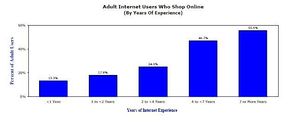Difference between revisions of "Buying preferences"
| Line 36: | Line 36: | ||
==Timing:== | ==Timing:== | ||
1979 Online shopping was invented in the UK | |||
1990: Tim Berners-Lee writes the first web browser, WorldWideWeb, using a NeXT computer. | |||
1992: J.H. Snider and Terra Ziporyn publish Future Shop: How New Technologies Will Change the Way We Shop and What We Buy. St. Martin's Press. ISBN 0312063598. | |||
1994: Netscape releases the Navigator browser in October under the code name Mozilla. Pizza Hut offers pizza ordering on its Web page. The first online bank opens. Attempts to offer flower delivery and magazine subscriptions online. Adult materials also becomes commercially available, as do cars and bikes. Netscape 1.0 is introduced in late 1994 SSL encryption that made transactions secure. | |||
1995: Jeff Bezos launches Amazon.com and the first commercial-free 24 hour, internet-only radio stations, Radio HK and NetRadio start broadcasting. Dell and Cisco begin to aggressively use Internet for commercial transactions. eBay is founded by computer programmer Pierre Omidyar as AuctionWeb. | |||
1998: Electronic postal stamps can be purchased and downloaded for printing from the Web. | |||
1999: Business.com sold for US $7.5 million to eCompanies, which was purchased in 1997 for US $149,000. The peer-to-peer filesharing software Napster launches. ATG Stores launches to sell decorative items for the home online. | |||
2000: The dot-com bust. | |||
2002: eBay acquires PayPal for $1.5 billion [6]. Niche retail companies CSN Stores and NetShops are founded with the concept of selling products through several targeted domains, rather than a central portal. | |||
2003: Amazon.com posts first yearly profit. | |||
2007: Business.com acquired by R.H. Donnelley for $345 million[7]. | |||
2008: US eCommerce and Online Retail sales projected to reach $204 billion, an increase of 17 percent over 2007[8]. | |||
http://en.wikipedia.org/wiki/E-commerce | http://en.wikipedia.org/wiki/E-commerce | ||
Revision as of 19:00, 8 September 2009
Description:
Editing by Roel Kock (EMBA09)
Buying preferences from people is a key factor for the developement of the Internet. In some cases some new business have been successful in selling products by internet, as it is the case of CD's, airlines, etc. But in other cases the business has been a fail (e.g. grocery).
Some stores that started with one simple product (e.g. books or CD's) are now offering a wide variety of products. www.amazon.com is maybe the best example of this.
Enablers:
- Increasing trust in the internet transactions; more experienced consumers (see graph) and more trusted brands on the internet
- Secure comerce; increase in secured payments and secured delivery
- Encriptation technologies; increase in secure payments
- Change in laws to protect the consumer
- Wider variety of products being offered which makes 'one stop shopping' easier
- Easier to compare various products on price and quality also consumer evaluations on products and product bloggs on experiences
- Increase in 'second hand' buying
- More international offering of product (cheaper)
- More tailor made products (e.g. NikeID)
- Better and easier search, look and feel of the product
Inhibitors:
- Lack of safety in internet transactions
- Not trusty internet sites
- Not adequate logistic services (services are increasing and getting cheaper e.g. www.cdwow.com which has no delivery costs)
Paradigms:
- People do not trust on Internet for transactions, rather consumers prefer go to shop
- With Internet consumers save time and money in the transactions
Experts:
Please add any comments to the links below.
Timing:
1979 Online shopping was invented in the UK 1990: Tim Berners-Lee writes the first web browser, WorldWideWeb, using a NeXT computer. 1992: J.H. Snider and Terra Ziporyn publish Future Shop: How New Technologies Will Change the Way We Shop and What We Buy. St. Martin's Press. ISBN 0312063598. 1994: Netscape releases the Navigator browser in October under the code name Mozilla. Pizza Hut offers pizza ordering on its Web page. The first online bank opens. Attempts to offer flower delivery and magazine subscriptions online. Adult materials also becomes commercially available, as do cars and bikes. Netscape 1.0 is introduced in late 1994 SSL encryption that made transactions secure. 1995: Jeff Bezos launches Amazon.com and the first commercial-free 24 hour, internet-only radio stations, Radio HK and NetRadio start broadcasting. Dell and Cisco begin to aggressively use Internet for commercial transactions. eBay is founded by computer programmer Pierre Omidyar as AuctionWeb. 1998: Electronic postal stamps can be purchased and downloaded for printing from the Web. 1999: Business.com sold for US $7.5 million to eCompanies, which was purchased in 1997 for US $149,000. The peer-to-peer filesharing software Napster launches. ATG Stores launches to sell decorative items for the home online. 2000: The dot-com bust. 2002: eBay acquires PayPal for $1.5 billion [6]. Niche retail companies CSN Stores and NetShops are founded with the concept of selling products through several targeted domains, rather than a central portal. 2003: Amazon.com posts first yearly profit. 2007: Business.com acquired by R.H. Donnelley for $345 million[7]. 2008: US eCommerce and Online Retail sales projected to reach $204 billion, an increase of 17 percent over 2007[8]. http://en.wikipedia.org/wiki/E-commerce
Web Resources:
Journal of Internet Banking and Commerce [1]
Taxonomy of the Interner Comerce [2]
